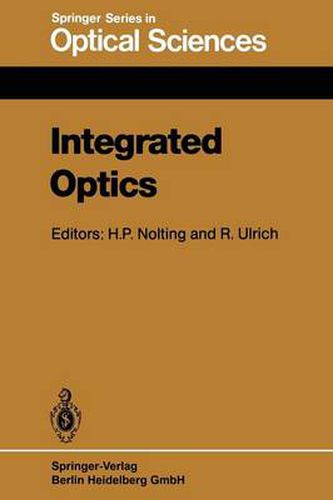Readings Newsletter
Become a Readings Member to make your shopping experience even easier.
Sign in or sign up for free!
You’re not far away from qualifying for FREE standard shipping within Australia
You’ve qualified for FREE standard shipping within Australia
The cart is loading…






This title is printed to order. This book may have been self-published. If so, we cannot guarantee the quality of the content. In the main most books will have gone through the editing process however some may not. We therefore suggest that you be aware of this before ordering this book. If in doubt check either the author or publisher’s details as we are unable to accept any returns unless they are faulty. Please contact us if you have any questions.
The development of miniaturized and ruggedized optical circuits, containing a number of optical and perhaps also electronic components integrated on the same substrate, and performing useful optical functions - this is the goal of the key technologies for future systems of communication, of instrumenta tion, and of general signal processing; it is expected to combine and to complement the established technologies of microelectronics, optoelectronics, and fiber-optics. Today, after more than fifteen years of research on integrated optics, this goal appears to be almost within reach. The theoretical problems of 1ight propagation and of numerous forms of coupling and interactions in integrated-optical structures are generally well understood. A great variety of single components for integrated optics has been demonstrated experimen tally, and more recently also the successful integration of several compo nents on a common substrate. Laboratory operation of such integrated-optical ‘chips’ has been reported, e.g., for RF spectrum analysis, for high-speed analog/digital conversion, for a fiber-optic gyro, and for various high-per formance semiconductor laser sources. Before commercial fabrication and technical application of such devices can take place, however, their performance has to be further improved. Se rious technological and material problems are still to be overcome which are related to the small transverse dimensions and high optical power densities typical for integrated-optical waveguides. Progress can be expected here by further improvements and diversifications of micro-fabrication technologies and (perhaps more efficiently) by learning how to better adapt the optical structures to the existing technologies.
$9.00 standard shipping within Australia
FREE standard shipping within Australia for orders over $100.00
Express & International shipping calculated at checkout
This title is printed to order. This book may have been self-published. If so, we cannot guarantee the quality of the content. In the main most books will have gone through the editing process however some may not. We therefore suggest that you be aware of this before ordering this book. If in doubt check either the author or publisher’s details as we are unable to accept any returns unless they are faulty. Please contact us if you have any questions.
The development of miniaturized and ruggedized optical circuits, containing a number of optical and perhaps also electronic components integrated on the same substrate, and performing useful optical functions - this is the goal of the key technologies for future systems of communication, of instrumenta tion, and of general signal processing; it is expected to combine and to complement the established technologies of microelectronics, optoelectronics, and fiber-optics. Today, after more than fifteen years of research on integrated optics, this goal appears to be almost within reach. The theoretical problems of 1ight propagation and of numerous forms of coupling and interactions in integrated-optical structures are generally well understood. A great variety of single components for integrated optics has been demonstrated experimen tally, and more recently also the successful integration of several compo nents on a common substrate. Laboratory operation of such integrated-optical ‘chips’ has been reported, e.g., for RF spectrum analysis, for high-speed analog/digital conversion, for a fiber-optic gyro, and for various high-per formance semiconductor laser sources. Before commercial fabrication and technical application of such devices can take place, however, their performance has to be further improved. Se rious technological and material problems are still to be overcome which are related to the small transverse dimensions and high optical power densities typical for integrated-optical waveguides. Progress can be expected here by further improvements and diversifications of micro-fabrication technologies and (perhaps more efficiently) by learning how to better adapt the optical structures to the existing technologies.